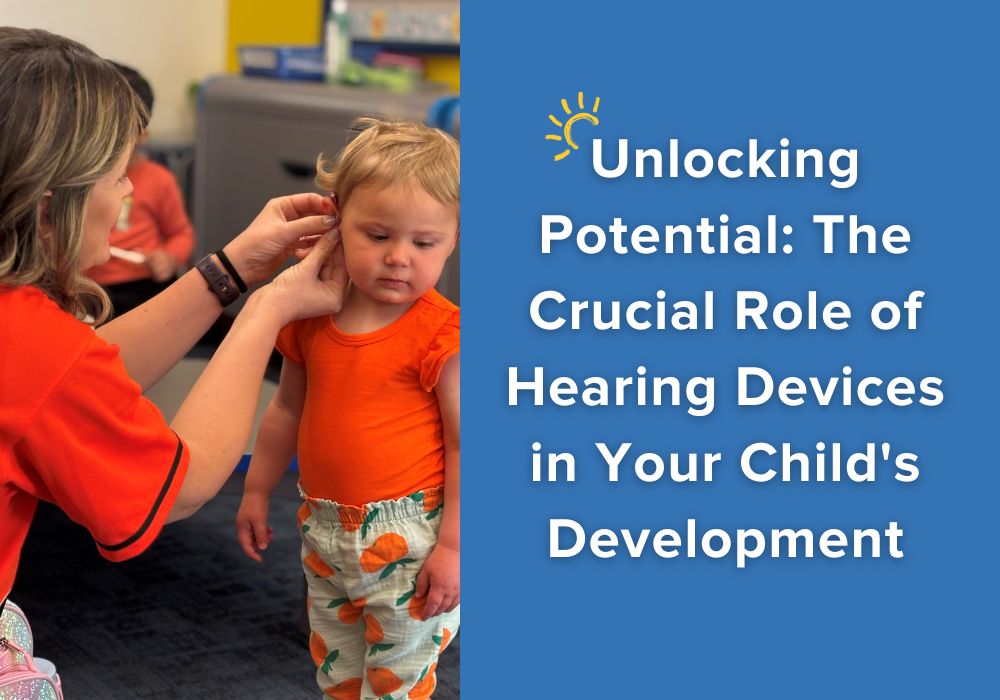Unlocking Potential: The Crucial Role of Hearing Devices in Your Child's Development
Why Wearing Hearing Aids and Cochlear Implants All Day Matters for Children Who Are Deaf and Hard of Hearing

Early diagnosis and amplification are crucial in ensuring that your child who is Deaf and Hard of Hearing (DHH) is successful with listening and spoken language. But once your child is fitted with hearing aids and cochlear implants, the work is just beginning.
You can give your child who is DHH the best chance at success by having them wear their hearing-assistive devices for all waking hours. This may seem daunting, but its importance cannot be understated.
Understanding All Waking Hours: Setting the Stage for Success
Removing cochlear implants and hearing aids at bedtime is acceptable and has multiple benefits. Devices will remain safe, batteries can be recharged, your child’s ears and equipment can air out, and sleep may be more comfortable.
When it is recommended that equipment is worn for all waking hours, this means that when your child wakes up, they should immediately put on their hearing aids or cochlear implants. There may be circumstances that lead to devices being removed from time to time, but this hearing-assistive technology should be functioning and on their heads while they are awake. Depending on sleep schedules, this can result in 12 to 16 hours of wear time.
The Impact of Wearing Hearing Devices Throughout the Day

Children who are DHH who are trying to develop listening and spoken language have to work harder to do so than children with typical hearing. They may also be trying to catch up from missed development time before they received amplification.
While children with typical hearing are receiving auditory input 24 hours a day, children who are DHH must do their best to also achieve this goal. Wearing equipment for all waking hours allows children who are DHH to maximize auditory input and stimulate auditory development. This, in turn, leads to the building of proficient speech, language, and literacy skills.
Every minute that a child who is DHH is not wearing their listening devices is a missed opportunity to enhance development. It may seem inconsequential at the time, but for a child working hard to maintain pace with listening peers, it is important to capitalize on every chance to increase development.
Ensuring Optimal Performance: Keeping Hearing Aids and Cochlear Implants in Top Shape
While wearing devices for all waking hours is supremely important, it becomes critical that hearing aids and cochlear implants are working efficiently to maximize success. A device producing distorted sound or no sound at all is a hindrance to your child’s development and can negate the positive effects of wearing equipment for all waking hours. Taking care of your hearing-assistive technology is imperative.
Daily listening checks, where your child repeats a series of sounds, can alert you to possible issues with sound quality. Older children may be able to express problems they are having with sound, but for younger children and toddlers, using your device’s testing equipment to listen for yourself should be done daily.
Routine audiological appointments should be kept to maintain optimal sound quality. Your audiologist can check for sound imperfections, troubleshoot issues and put your child in the best position to maximize development moving forward.
Overcoming Common Challenges: Tips for Encouraging Daily Device Usage
CCHAT understands that getting your child to wear their devices for all waking hours can be a challenge. We encourage you to read our Strategies for Keeping Hearing Aids and Cochlear Implants on Young Children. Additionally, CCHAT has many parents and staff members who have faced this challenge and who are willing to talk to you about the obstacles you are facing. Use our contact page to share your questions and receive tips specific to your child.
The Bottom Line: Why Consistent Use of Hearing Technology is Essential for Development
The development of listening and spoken language cannot happen if a child is not receiving sound. Wearing hearing aids and cochlear implants for all waking hours gives children who are DHH every chance to grow their skills and achieve academic outcomes on par with their hearing peers. Hearing-assistive technology should be a constant for your child.
For more helpful tips to maximize your child’s development, visit our blog section. To learn about the services CCHAT provides to children who are DHH and their families, visit our programs page.





%20(1).png)








































.png)





